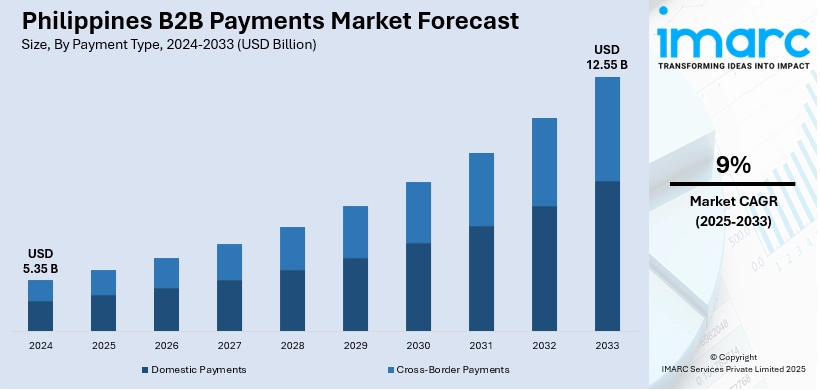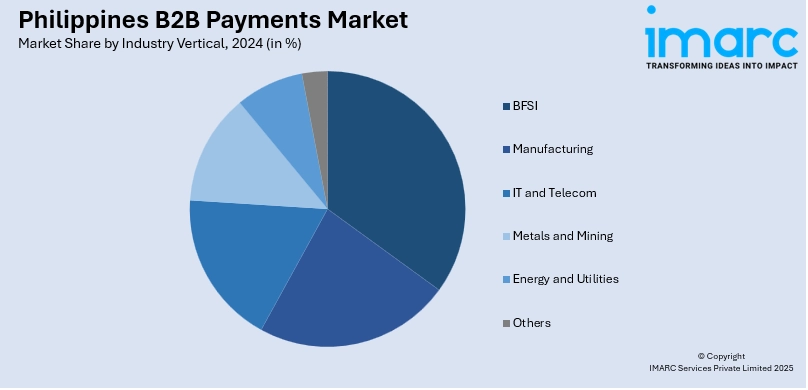
Philippines B2B Payments Market Size, Share, Trends and Forecast by Payment Type, Payment Mode, Enterprise Size, Industry Vertical, and Region, 2025-2033
Philippines B2B Payments Market Overview:
The Philippines B2B payments market size reached USD 5.35 Billion in 2024. The market is projected to reach USD 12.55 Billion by 2033, exhibiting a growth rate (CAGR) of 9% during 2025-2033. Rapid digital adoption among SMEs, government-backed financial inclusion programs, expansion of e-commerce, increasing mobile penetration, and rising demand for efficient cross-border payments are some of the factors contributing to the Philippines B2B payments market share. Fintech innovations and real-time payment infrastructure upgrades also strengthen market growth.
|
Report Attribute
|
Key Statistics
|
|---|---|
|
Base Year
|
2024
|
|
Forecast Years
|
2025-2033
|
|
Historical Years
|
2019-2024
|
| Market Size in 2024 | USD 5.35 Billion |
| Market Forecast in 2033 | USD 12.55 Billion |
| Market Growth Rate 2025-2033 | 9% |
Philippines B2B Payments Market Trends:
Surge in Digital Wallet and Real-Time Payment Adoption
In the Philippines, B2B payments are shifting rapidly toward digital wallets and real-time settlement systems. The pandemic accelerated this move, as businesses sought ways to maintain supply chain efficiency without relying on manual check processing or over-the-counter bank transactions. Platforms like GCash and PayMaya, initially popular in consumer markets, are now being integrated into corporate workflows, particularly for small and medium enterprises (SMEs). These tools allow instant fund transfers, reduce reconciliation delays, and lower transaction costs compared to traditional banking channels. The launch of the Bangko Sentral ng Pilipinas’ (BSP) InstaPay and PESONet systems also plays a role, giving companies low-cost, fast, and reliable options for vendor and distributor payments. This trend is particularly impactful for businesses working with multiple regional partners, where speed and transparency of payment are essential. The ability to track transactions in real time is also helping reduce fraud risks and disputes. Overall, digital-first B2B payment models are becoming a mainstream expectation, not a niche alternative. These factors are intensifying the Philippines B2B payments market growth.

To get more information on this market, Request Sample
Growing Importance of Cross-Border B2B Payment Solutions
As Philippine companies expand trade with partners across Southeast Asia and beyond, the demand for efficient cross-border B2B payment systems is rising. Traditional international transfers often come with high fees, long processing times, and exchange rate risks, creating friction for importers, exporters, and outsourcing firms. To address these issues, businesses are increasingly turning to fintech solutions that streamline cross-border payments through blockchain-based settlement, multicurrency digital wallets, and partnerships with global payment networks. For instance, companies in the outsourcing and IT sectors, which frequently receive payments from clients in the US and Europe, are adopting platforms that support faster settlement in multiple currencies. At the same time, import-heavy sectors such as manufacturing and retail are looking for providers that offer more favorable forex terms and transparent fee structures. This shift reflects a broader push toward reducing reliance on conventional SWIFT transfers and embracing digital channels that cut both costs and delays. As trade activity intensifies, cross-border payment innovation is set to become a major growth driver in the Philippines’ B2B payments market.
Philippines B2B Payments Market Segmentation:
IMARC Group provides an analysis of the key trends in each segment of the market, along with forecasts at the country and regional level for 2025-2033. Our report has categorized the market based on payment type, payment mode, enterprise size, and industry vertical.
Payment Type Insights:
- Domestic Payments
- Cross-Border Payments
The report has provided a detailed breakup and analysis of the market based on the payment type. This includes domestic payments and cross-border payments.
Payment Mode Insights:
- Traditional
- Digital
The report has provided a detailed breakup and analysis of the market based on the payment mode. This includes traditional and digital.
Enterprise Size Insights:
- Large Enterprises
- Small and Medium-sized Enterprises
The report has provided a detailed breakup and analysis of the market based on the enterprise size. This includes large enterprises and small and medium-sized enterprises.
Industry Vertical Insights:

- BFSI
- Manufacturing
- IT and Telecom
- Metals and Mining
- Energy and Utilities
- Others
The report has provided a detailed breakup and analysis of the market based on the industry vertical. This includes BFSI, manufacturing, IT and telecom, metals and mining, energy and utilities, and others.
Regional Insights:
- Luzon
- Visayas
- Mindanao
The report has also provided a comprehensive analysis of all the major regional markets, which include Luzon, Visayas, and Mindanao.
Competitive Landscape:
The market research report has also provided a comprehensive analysis of the competitive landscape. Competitive analysis such as market structure, key player positioning, top winning strategies, competitive dashboard, and company evaluation quadrant has been covered in the report. Also, detailed profiles of all major companies have been provided.
Philippines B2B Payments Market News:
- June 2025: PingPong, a global cross-border payments provider, strengthened its Southeast Asia presence with a new Money Services Business Licence from Malaysia’s central bank. This builds on its recent entry into Indonesia and its existing operations in Vietnam, Thailand, Singapore, and the Philippines. With over 60 licences worldwide, PingPong is enabling enterprises and SaaS firms to tap into regional B2B payment opportunities, including the growing Philippines market.
Philippines B2B Payments Market Report Coverage:
| Report Features | Details |
|---|---|
| Base Year of the Analysis | 2024 |
| Historical Period | 2019-2024 |
| Forecast Period | 2025-2033 |
| Units | Billion USD |
| Scope of the Report |
Exploration of Historical Trends and Market Outlook, Industry Catalysts and Challenges, Segment-Wise Historical and Future Market Assessment:
|
| Payment Types Covered | Domestic Payments, Cross-Border Payments |
| Payment Modes Covered | Traditional, Digital |
| Enterprise Sizes Covered | Large Enterprises, Small and Medium-sized Enterprises |
| Industry Verticals Covered | BFSI, Manufacturing, IT and Telecom, Metals and Mining, Energy and Utilities, Others |
| Regions Covered | Luzon, Visayas, Mindanao |
| Customization Scope | 10% Free Customization |
| Post-Sale Analyst Support | 10-12 Weeks |
| Delivery Format | PDF and Excel through Email (We can also provide the editable version of the report in PPT/Word format on special request) |
Key Questions Answered in This Report:
- How has the Philippines B2B payments market performed so far and how will it perform in the coming years?
- What is the breakup of the Philippines B2B payments market on the basis of payment type?
- What is the breakup of the Philippines B2B payments market on the basis of payment mode?
- What is the breakup of the Philippines B2B payments market on the basis of enterprise size?
- What is the breakup of the Philippines B2B payments market on the basis of industry vertical?
- What is the breakup of the Philippines B2B payments market on the basis of region?
- What are the various stages in the value chain of the Philippines B2B payments market?
- What are the key driving factors and challenges in the Philippines B2B payments market?
- What is the structure of the Philippines B2B payments market and who are the key players?
- What is the degree of competition in the Philippines B2B payments market?
Key Benefits for Stakeholders:
- IMARC’s industry report offers a comprehensive quantitative analysis of various market segments, historical and current market trends, market forecasts, and dynamics of the Philippines B2B payments market from 2019-2033.
- The research report provides the latest information on the market drivers, challenges, and opportunities in the Philippines B2B payments market.
- Porter's Five Forces analysis assists stakeholders in assessing the impact of new entrants, competitive rivalry, supplier power, buyer power, and the threat of substitution. It helps stakeholders to analyze the level of competition within the Philippines B2B payments industry and its attractiveness.
- Competitive landscape allows stakeholders to understand their competitive environment and provides an insight into the current positions of key players in the market.
Need more help?
- Speak to our experienced analysts for insights on the current market scenarios.
- Include additional segments and countries to customize the report as per your requirement.
- Gain an unparalleled competitive advantage in your domain by understanding how to utilize the report and positively impacting your operations and revenue.
- For further assistance, please connect with our analysts.
 Request Customization
Request Customization
 Speak to an Analyst
Speak to an Analyst
 Request Brochure
Request Brochure
 Inquire Before Buying
Inquire Before Buying




.webp)




.webp)












